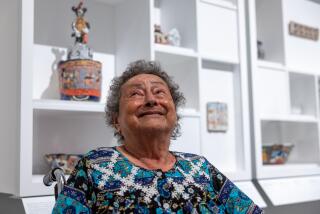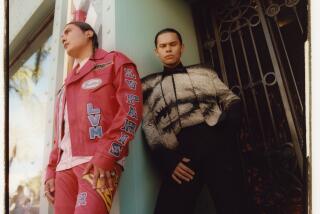Victor Quiñonez highlights immigrants’ humanity with ‘I.C.E. Scream’ sculptures

- Share via
“I scream, you scream, we all scream for ice cream” is more than a novelty song for Victor Quiñonez.
Marking his art fair debut at Frieze, the Brooklyn-based artist examines Indigeneity and the treatment of immigrants with “I.C.E. Scream,” a series of acrylic ice-cream-shaped sculptures. He draws on personal experiences about emigrating from Mexico and his local communities to emphasize immigrants’ humanity. Awarded this year’s Frieze Impact Prize, he says he hopes the piece serves as “a sign of relief to show that artists care.”
“At first glance, you’re like, ‘Oh, wow, that’s a popsicle.’ You want to approach it. It brings back nostalgia for everyone. It symbolizes something fun, innocent and childlike,” said Quiñonez. “But then when you get closer, you see the writing on the popsicle sticks. … I wanted to show the two different sides of the world that we’re living in.”
Frieze L.A. 2025 and the rest of L.A. art week is upon us. Here’s your short list of can’t-miss exhibitions, talks, parties and other places to go.
The bottom of each popsicle stick is stamped with the ICE logo and the words “U.S. Inhumane and Cruelty Enforcement” — a play on U.S. Immigration and Customs Enforcement. Some of Quiñonez’s larger-than-life ice creams are perfectly intact while others appear to be melting. Each of the bright neon resin structures spotlight a variety of images and items that reflect the immigrant experience. In some, smiling street vendors peek through and in others, an American flag and pairs of handcuffs fill the space.
Quiñonez says he wanted to emphasize the beauty of immigrant culture, instead of its victimization. The idea for this project stemmed from a piece he created as a resident artist at MASS MoCA, where he turned an ice chest into an ofrenda — altar — dedicated to all undocumented street vendors.
“I wanted to show just how much I appreciate what they do for the community and what they do for their families. Because when you first come here, the only way you can really survive is by having these small, independent ways of making money,” said Quiñonez. “That’s one of the first symbols of independence — selling water, fruit, tamales in that cooler and making enough for your family, and hoping you can grow from that.”
Presenting never-before-seen ephemera and the works of 19 contemporary Black artists, the Hammer Museum pays homage to the life and impact of musician and spiritual leader Alice Coltrane.
The distinct horn of a paletero (ice cream man) can be heard in almost every Los Angeles park and public gathering place as they sell fruit-flavored paletas, a Mexican frozen treat, or cartoon-shaped pops with gumball eyes from a pushcart. Quiñonez used the dessert, which represents the joys of childhood, to symbolize the harsh realities of the anti-immigrant movement.
Since his inauguration, President Trump has signed a flurry of executive orders that will revamp the country’s immigration system. He declared a national emergency at the southern border, attempted to end birthright citizenship and limited legal pathways to enter the U.S. Last month during a news conference, White House Press Secretary Karoline Leavitt said the administration views all undocumented immigrants as criminals because they have violated immigration laws. ICE raids have also been conducted in cities including New York and Chicago.
As the streets of major cities across the country are flooded with pro-immigration/anti-ICE protests, Quiñonez, who immigrated to Dallas from Mexico at age 4, emphasizes that this movement isn’t new. Growing up, his father was deported several times. In the months his father was gone, he and his mother relied on their local church to keep them fed.

“It’s just that this administration is blatantly, for lack of better words, evil when it comes to how they handle deportation,” said Quiñonez, who became a citizen four years ago. “I thought about my personal journey and how many times I’ve had to beg for my residency to be renewed. Or when I was rejected four times when I applied for my citizenship — as someone who was able to go to college and understands everything that it takes to apply — I was still rejected because they make it so complicated.”
Reflecting on the tumultuous ups and downs of his naturalization battle, he recalls finding his footing in the world of art — through graffiti. As a teenager in Texas, he spent his free time spray-painting freight trains and practicing the lettering of his moniker, Marka27.
Halsey shares the seeds and vision behind her much-anticipated Summaeverything Community Center in L.A.
“It was my way of escaping what was going around in my environment. I grew up in Dallas in the late ’80s/early ’90s, and during that time, there were a lot of gangs,” said Quinonez. “For me, graffiti was a way to escape that reality, go paint and do something that felt creative.”
His form of artistic expression came with consequences. Facing a felony charge and jail time, he spent the majority of his adolescence in trouble with the law for vandalism. During high school, he was introduced to Mexican muralism and decided to instead paint murals that could directly impact his community.
Today, his murals can be seen all over the East Coast. Using bright colors and geometric shapes, he often focuses on large-scale portraiture of Indigenous people. With each of his murals, he says he hopes “to change the way we see ourselves, and I want people to change the way they see us.”

“It’s political because when someone looks up at a massive mural that’s painted 80 feet high and they see an Indigenous person or a Latina, all of a sudden a little girl could see herself in that mural and say, ‘I’m worth something because somebody painted someone that looks like me in my neighborhood,’” said Quiñonez.
Whether Quiñonez is creating a wall-sized mural, painting a standard canvas in his studio or making sculptures, he looks to the same subject matter for inspiration. Everything he makes is centered around people of color who struggle but show strength. He says his subjects remind him of his parents.
“After witnessing my father get deported more than once and seeing how that affected our family and how hard my mom worked, I really always respected that hustle and that resilience, and that’s always carried with me for decades,” said Quiñonez.
His father died from complications of COVID-19 in Mexico during the pandemic and his mother is retired, living in Merida, Mexico.
In addition to his debut at Frieze, Quiñonez will have his first major solo exhibition, “Ni De Aquí Ni De Allá,” at Boston University’s Stone Gallery later this year.
More to Read
The biggest entertainment stories
Get our big stories about Hollywood, film, television, music, arts, culture and more right in your inbox as soon as they publish.
You may occasionally receive promotional content from the Los Angeles Times.














